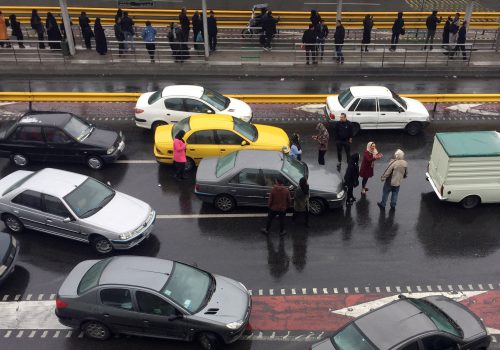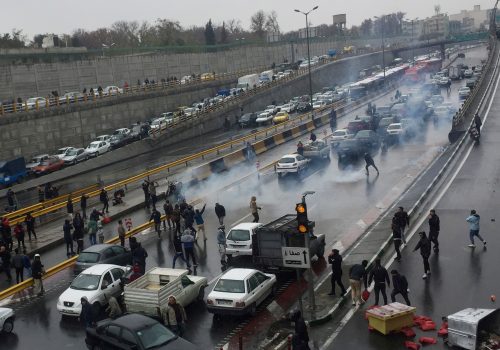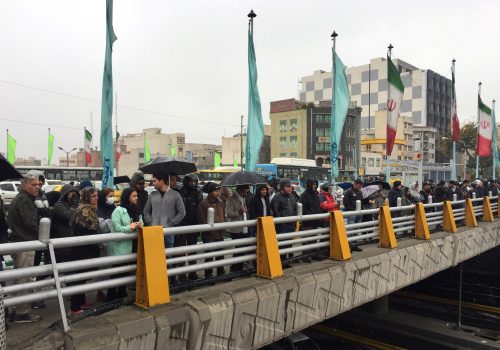January 26, 2022
Aban will not die: How truth remains a powerful weapon against the Islamic Republic
NOTE: Aban is the month that the atrocities took place in the Iranian calendar.
He wore a hat, sunglasses, and mask to hide his identity while testifying before The Iran Atrocities (Aban) Tribunal on November 10, 2021. His voice was dubbed over in real-time by a member of the Tribunal counsel team. Witness number 185 was a man close to the Friday prayer imam in one of Iran’s large cities.
The witness testified about the imam’s horrific role, as Supreme Leader Ayatollah Ali Khamenei’s representative, in directing province authorities to issue an order to kill protestors in the violent crackdown during the November 2019 protests. All precautions had been taken to conceal the witness’ identity. However, the counsel team was concerned about his safety and security after his testimony was broadcast live from the Tribunal room in London to thousands of homes in Iran via diaspora satellite channels. So, they called to check on him. The witness didn’t pick up. The counsel team called him multiple times. There was no answer.
The Tribunal session was ongoing and the counsel team had to move on to other witnesses. But the worries didn’t cease. Had witness 185 been arrested? Three hours later, he called back, saying: “I’m sorry that I couldn’t take your calls. I was in a fast food restaurant with my family. Everyone was talking about witness 185 and I was listening to the conversations!”
A history of tribunals
On November 15, 2019, the Iranian government announced that fuel prices were set to triple. Ordinary citizens, already suffering from great economic malaise, took to the streets to protest. The nationwide protests were peaceful and consisted, primarily, of people blocking roads with their cars and chanting slogans. Nevertheless, the state response was brutal and left thousands killed, injured, detained, and tortured. In under a week, the protests were suppressed, accompanied by a total internet shutdown to cover up the crimes. Two years later, from November 10-14, The Iran Atrocities (Aban) Tribunal in London investigated if Iranian government officials, police, and military forces had committed crimes against humanity.
The Iran Atrocities (Aban) Tribunal is a people’s tribunal consisting of six independent and internationally-renowned lawyers from South Africa, the United Kingdom, Indonesia, Canada, the United States, and Libya. People’s tribunals first appeared in 1966 when Bertrand Russell initiated the International War Crimes Tribunal, known as the Russell Tribunal. This was a reaction to the world’s poor response towards the crimes committed by the US during the Vietnam war.
Since then, many civil society groups have applied a similar model. These grassroots movements towards justice involve an unofficial but legal setting to counter the absolute impunity enjoyed by perpetrators of international crimes. Some have achieved changes beyond rectifying historical records and empowering victims’ communities.
For instance, the International People’s Tribunal on Human Rights and Justice’s findings led to the opening of a government investigation in 2011 on unmarked and mass graves in Jammu and Kashmir. The findings of the 2021 Uyghur Tribunal of genocide in Xinjiang province have intensified the global movement to hold Chinese authorities accountable. This includes a push to boycott the Beijing 2022 Winter Olympics. The final judgment of the 2011-2013 Iran Tribunal on the mass-killings of political prisoners in 1980 was used by Swedish prosecution as evidence for their indictment in Hamid Noury’s trial, an assistant to the deputy prosecutor in one of Iran’s prisons where hundreds of political prisoners were summarily executed in the summer of 1988.
Dealing with the testimonies of current and former officials
The public hearings of The Iran Atrocities (Aban) Tribunal stayed in the headlines of almost all Iranian diaspora media outlets for five days. Popular satellite television channels and other news outlets, run by exiled journalists, boldly resisted the state’s censorship rules. Their broadcasts featured hours of heart-breaking testimonies by mothers and other relatives of the victims as well as protestors who were injured, arrested, or otherwise affected. Courageous witnesses risked their lives to be heard, helping it become the most-watched event in Iran’s history of civil activism, having over fifteen million viewers inside the country.
Despite the tendency of Iranian officials to ignore human rights criticisms, the Tribunal extracted a reaction due to its significant impact on public opinion. Some officials called the Tribunal a “British stunt,” while others said that the US or “Zionists”—a reference to Israel—had it set up as a theatrical show. Hassan Norouzi, a member of parliament and spokesman for parliament’s judicial committee, stunned the public by announcing on November 13, 2021: “I was one of the people who shot at the protestors. The other side set fire to the banks and we killed them. Now, who wants to put us on trial?” At the hearings the next day, the Tribunal Counsel announced that the official would be added to the list of 133 accused, as identified in their indictment, for his incriminating words.
However, neither the popularity of the hearing nor the government reactions were the most significant contributions of this tribunal. It was the fact that government officials, former and current, volunteered to publicly testify, which included two police officers and two government employees. Up until the testimony of the first government official, witness number 185, the public had only heard the accounts of the protestors and victims’ families. These “new” witnesses shared truths that would otherwise not have been uncovered as long as the Islamic Republic was in power. Nevertheless, they could also be perpetrators or, at least, accomplices in the crimes they described. For instance, one of the police officers reported on a particular strategy used by the security apparatus: releasing criminals from prison and using them as agent-provocateurs to damage banks and properties while pretending to be protesters.
For the counsel team, who were not only professional researchers but also victims of state persecution, it was not easy to conquer their anger and agony while obtaining these testimonies. It was even more difficult for other witnesses and members of the affected community to watch these individuals continue their lives without being challenged by the judges about their roles in the atrocities. The testimonies of former and current officials have triggered online political debates over how Iranian society—particularly victims of the state—should reconcile with defectors of the regime—both now and in an eventual democratic transition.
One thing was clear among all the political debates: over the five days of the hearing and, in front of the eyes of the public, bit by bit, pieces of the truth were put together. The Tribunal acted like a truth commission despite the authoritarian regime still being in power.
In light of the scope of new evidence being offered to the Tribunal, a second hearing has been scheduled for February 4-6 to hear and examine the new witnesses. The Iranian government still has the opportunity to respond, as international law demands, to the compelling evidence on a variety of crimes against humanity. In his closing speech on November 14, 2021, Wayne Jordash, the chairperson of the panel of judges, succinctly noted these crimes.
The judgment of the Tribunal is due this Spring. Like that of similar people tribunals, it will not be legally binding. However, a legal document produced by a group of internationally-acclaimed, impartial, and independent lawyers won’t simply be a document for bookshelves. Rather, it will act as a powerful tool to trigger a United Nations-led independent inquiry, the sanctioning of all individuals and entities responsible, the placing of perpetrators on the dock based on the principle of Universal Jurisdiction, and, ultimately, meaningful change that could put an end to impunity.
Shadi Sadr is a human rights lawyer and a member of the panel of judges at the International People’s Tribunals on Indonesia, Myanmar, and China. She co-founded and directed Justice for Iran, one of the organizers of the Iran Atrocities’ (Aban) Tribunal. Follow her on Twitter: @shadisadr.
Further reading
Wed, Mar 24, 2021
#No2IslamicRepublic: Just a hashtag or much more?
IranSource By
On March 11, an anti-government campaign was launched with the hashtag #No2IslamicRepublic in English and Persian. The movement was announced via a statement signed by 640 Iranians, including those inside and outside Iran.
Fri, Nov 13, 2020
A year after the November protests, human rights violators have not been held accountable in Iran
IranSource By Gissou Nia
Ideally, justice would be served by the Iranian leadership investigating violations and punishing perpetrators within their ranks. Unfortunately, that is not a realistic scenario.
Tue, Nov 9, 2021
From November 2019 to Khuzestan protests, lack of accountability is emblematic of Iran’s plague of impunity
IranSource By
Without concrete action to fight the plague of impunity that covers Iran, these violent events will only continue to occur and the Iranian people will continue to suffer.
Image: Nahid Shirpishe, whose son, Pouya Bakhtiari was killed during the November 2019 protests is testifying before the Iran’s Atrocities (Aban) Tribunal in London (Photo: Brian Fani)


